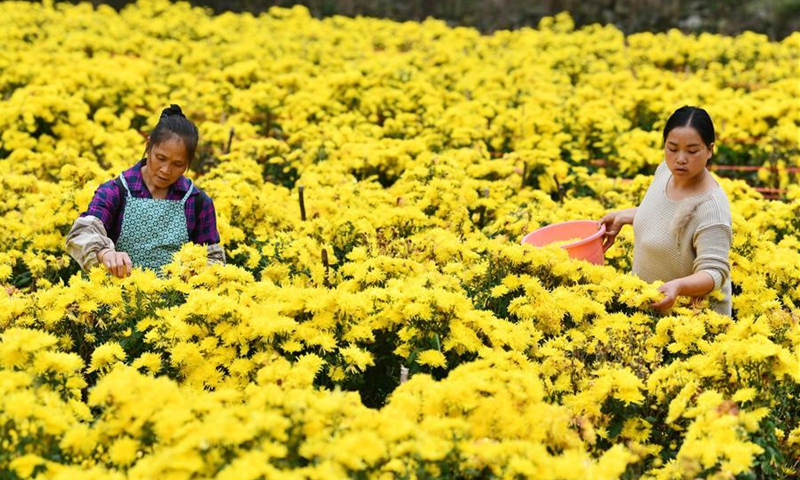China lifts all counties out of poverty
Alleviation efforts ‘starting point of new pursuits’

Villagers pluck chrysanthemum flowers in Jinxi Village of Xima Township, Longli County of southwest China's Guizhou Province, Oct. 27, 2020. Thanks to the chrysanthemum industry, 166 poverty-stricken households in Jinxi Village were lifted out of poverty in 2019. (Xinhua/Yang Wenbin)
All 832 national-level poor counties in China have been lifted out of poverty, after the last nine poverty-stricken counties in Southwest China's Guizhou Province were taken off the poverty list on Monday, which rural affairs experts hailed as a milestone and the starting point of new pursuits. They said the next step for China is to consolidate the achievement of poverty alleviation efforts and provide a sustainable mechanism to prevent people who beat poverty from falling back into it.
The provincial government of Guizhou announced at a Monday briefing that the last nine impoverished counties have been removed from the poverty list. After examination at the county, city and provincial levels, three third-party assessment agencies conducted field inspections in nine poverty-stricken counties in the province. The incidence of poverty was zero, media reported.
So far, 66 impoverished counties in Guizhou have ended poverty, which means that all the nation's 832 national-level impoverished counties have changed their status.
Once having the largest impoverished population in China, Guizhou now has the largest number of people lifted out of poverty. The number of impoverished people in the province stood at 9.23 million in 2012.
The per capita net income of the poverty-stricken households surveyed in the nine poverty-stricken counties is 11,487 yuan ($1,748), 7,487 yuan higher than China's poverty alleviation standard in 2020.
In 2014, China's State Council made public a list of 832 poverty-stricken counties as of that year, covering 22 provincial-level regions in China. At that time, about one in every three counties in China was impoverished, and only nine provincial-level regions in the Chinese mainland had zero poverty-stricken counties at all, media reported.
Poverty alleviation in China has accelerated since 2016, and by the end of 2019, the number of poverty-stricken counties had been reduced to 52, China Central Television (CCTV) reported, noting that all the 52 counties were taken care of by the poverty alleviation group under the State Council.
At least 10 million people in China were lifted out of poverty annually for seven consecutive years, and the number of people living in poverty decreased from 98.99 million at the end of 2012 to 5.51 million at the end of 2019, CCTV reported.
China has vowed to eradicate absolute poverty by the end of 2020. The outline of poverty alleviation amid the 13th Five-Year Plan (2016-20), issued by the State Council in 2016, said that by 2020, all impoverished people will be lifted out of poverty, with adequate food and clothing, compulsory education, basic medical care and housing security guaranteed; 128,000 improvised villages and 832 counties will be lifted out of poverty.
With the elimination of absolute poverty this year, China will achieve the poverty reduction target of the UN 2030 Agenda for Sustainable Development 10 years ahead of schedule.
The sweeping campaign to get rid of poverty was part of building a moderately and comprehensively prosperous society.
China's government-led poverty alleviation efforts have protected its citizens' right to life, and the end of impoverished counties means that the basic subsistence of all Chinese citizens is guaranteed, and also marks accomplishment of the mission in the outline, analysts said.
Realizing the poverty alleviation goal on schedule in 2020 is an impressive accomplishment as China is fighting many daunting challenges in the year, including the COVID-19 epidemic and floods.
Poverty alleviation in the past was more difficult because it relied mainly on the input of resources, said Yu Jianrong, director of Institution of Rural Development at the Chinese Academy of Social Sciences, noting that nowadays, poverty alleviation is a combination of relocation, industrial poverty alleviation, and social relief.
"Relocation means that the government helps residents move out of the mountains that are not suitable to live in, and move into free buildings provided by the government… The government will also provide jobs and help them make fundamental changes in their way of life," Yu explained, noting that the emergence of this mode is also related to China's urbanization.
China has relocated 9.3 million poverty-stricken people from harsh living environments, and built 39,000 resettlement areas with more than 2.6 million housing units, the National Development and Reform Commission announced in March.
For regions that are relatively suitable for living, the Chinese government provides industrial poverty alleviation, guiding the planting of cash crops and other efforts, in conjunction with social relief, Yu said.
Some experts warned that the possibility of a "return to poverty" exists because poverty is a fluid and relative concept.
In the next five years, the government should help people move out of poverty by helping them adapt to a new environment, providing employment security, and providing appropriate relief for serious diseases and schooling, Yu said.
In the next five years, efforts will be made to consolidate achievements in the fight against poverty and fully promote the strategy of rural vitalization, according to the Communist Party of China Central Committee's proposed major social and economic development targets for the 14th Five-Year Plan period (2021-25).
On the other hand, China needs to study and formulate new national poverty standards and gradually establish a long-term mechanism for stable income increases and poverty reduction, analysts said.